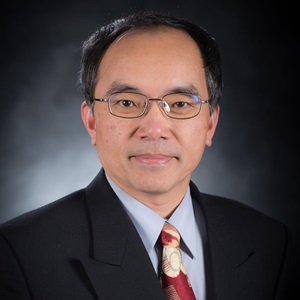Ching-An Peng, Ph.D., P.E.
Ching-An Peng, Ph.D., P.E.
Professor
Engineering Physics 410
208-885-7461
Chemical & Biological Engineering
University of Idaho
875 Perimeter Drive, MS 0904
Moscow, Idaho 83844-0904
- Ph.D., Chemical Engineering, University of Michigan, 1995
- M.S., Chemical Engineering, University of Notre Dame, 1990
- B.S., Chemical Engineering, National Taiwan University, 1985
Courses
- Cell and Gene Therapy
- Drug Delivery Systems
- Nanobiotechnology
- Protein Expression and Purification
- Biotransport Processes
- Senior Seminar
- Drug/gene delivery
- Nano/bio technology
- Cellular/tissue engineering
Ching-An Peng started his academic career as an assistant professor at the University of Southern California in Chemical Engineering Department and later on promoted to associate professor with tenure. He then worked at the National Taiwan University as a full professor and at Michigan Technological University as the first holder of the James and Lorna Mack Endowed Chair in Bioengineering. In 2015, he joined the University of Idaho. Over the course of his academic career, Peng has been involved with research in drug/gene delivery using viral and nonviral vectors as well as ultrasonic device, developing phagocytosis-resistant perfluorocarbon-based oxygen carriers using PEGylated fluorosurfactant and CD47 ligand, photothermolysis of cancer cells using nanomaterials, and detection of antiviral agents using nanobiosensors. A few of Peng’s studies are summarized below.
Drug/Gene Delivery
Polymeric drug/gene nanocarriers for gene-directed enzyme prodrug therapy are designed and synthesized to specifically target cancer cells and control the release of cytotoxic drugs inside the cancer cells for augmenting the effectiveness of anticancer treatment. Several enzyme/prodrug pairs and anticancer drugs have been coupled with polymeric micellar nanoparticles to deliver into cancer cells and showed anticancer activity. To achieve the goal of long blood circulation of drug/gene carriers, CD47-streptavidin fusion protein expressed in bacteria and purified by affinity chromatography is conjugated on biotinylated nanocarriers to explore its anti-phagocytic capability. Results show CD47-tagged nanoparticles can prevent phagocytosis by macrophage to a large extend. For the enhancement of gene delivery efficiency, both viral or nonviral approaches have been investigated.
Nano/Bio Technology
Developing fast and efficient screening technology has its merits of identifying potential drugs against viral diseases that still lack of effective prevention or treatment. Quantum dot, an emerging probe for biological imaging and medical diagnostics, is employed to form complexes with virus and used as fluorescent imaging probes for exploring potential antiviral therapeutics. Ultrasound contrast perfluorocarbon microbubble stabilized with PEG-based fluorosurfactant has been incorporated with nanomaterials to enhance the detecting capability. Perfluorocarbon microbubble can be further used to carry therapeutic drugs or genes to make it as a theranostic agent. Carbon nanotube and gold nanorod functionalized with tumor-specific monoclonal antibodies have been utilized along with near-infrared laser to selectively induce photothermolysis of specific malignant cells from a mixed cell population.
- Zhang J, Peng CA. Poly(N-isopropylacrylamide) modified polydopamine as temperature- responsive surface for cultivation and harvest of mesenchymal stem cells. Biomater Sci 5:2310- 2318, 2017.
- Christian D, Zhang J, Sawdon AJ, Peng CA. Enhanced astaxanthin accumulation in Haematococcus pluvialis using high carbon dioxide concentration and light illumination. Bioresour Technol 256:548- 551, 2018.
- Sawdon AJ, Zhang J, Wang X, Peng CA. Enhanced anticancer activity of 5’-DFUR-PCL-MPEG polymeric prodrug micelles encapsulating chemotherapeutic drugs. Nanomaterials 8:1041, 2018.
- Zhang J, Peng CA. Migration of mesenchymal stem cells tagged with carbon nanotubes under chemotactic gradient. RSC Adv 9:7156-7164, 2019.
- Zhang J, Peng CA. Enhanced proliferation and differentiation of mesenchymal stem cells by astaxanthin-encapsulated polymeric micelles. PLoS ONE 14(5):e0216755, 2019.
- Zhang J, Peng CA. Diminution of phagocytosed micro/nanoparticles by tethering with immunoregulatory CD200 protein. Sci Rep 10:8604, 2020.
- Tarar A, Alyami EM, Peng CA. Efficient expression of soluble recombinant protein fused with core-streptavidin in bacterial strain with T7 expression system. Methods Protoc 3:82, 2020.
- Tarar A, Alyami EM, Peng CA. Mesenchymal stem cells anchored with thymidine phosphorylase for doxifluridine-mediated cancer therapy. RSC Adv 11:1394-1403, 2021.
- Zhang J, Peng CA. Blockade of macrophage adhesion to CD200-treated polystyrene culture surface. J Biomed Mater Res A 109:365-373, 2021.
- Sawdon AJ, Zhang J, Peng S, Alyami EM, Peng CA. Polymeric nanovectors incorporated with ganciclovir and HSV-tk encoding plasmid for gene-directed enzyme prodrug therapy. Molecules 26:1759, 2021.
- Alyami EM, Tarar A, Peng CA. Less Phagocytosis of viral vectors by tethering with CD47 ectodomain. J Mater Chem B 10:64-77, 2022.
- Tarar A, Alyami EM, Peng CA. Eradication of myrosinase-tethered cancer cells by allyl isothiocyanate derived from enzymatic hydrolysis of sinigrin. Pharmaceutics 14:144, 2022.
- Zhang J, Tsai WY, Hsu CH, Peng CA. Biodiesel production from Nannochloropsis oculata cultured at high CO2 concentration associated with high illumination. Biofuels 13:527-535, 2022.
- Tarar A, Peng CA. Enhancement of antibacterial activity of sinigrin-capped silver nanoparticles in combination with myrosinase. J Environ Chem Eng 10:107796, 2022.
- Lin YY, Takemoto JY, Chang CWT, Peng CA. Mesobiliverdin IXα ameliorates osteoporosis via promoting osteogenic differentiation of mesenchymal stem cells. Biochem Biophy Res Comm 619:56- 61, 2022.
- Tarar A, Peng S, Cheema S, Peng CA. Anticancer activity, mechanism, and delivery of allyl isothiocyanate. Bioengineering 9:470, 2022.
- Peng I, Jokhio S, Alkhaldi S, Peng CA. Inactivation of SARS-CoV-2 spike protein pseudotyped virus infection using ACE2-tethered gold nanorods under near-infrared laser irradiation. ACS Appl Nano Mater 5:15942-15953, 2022.







